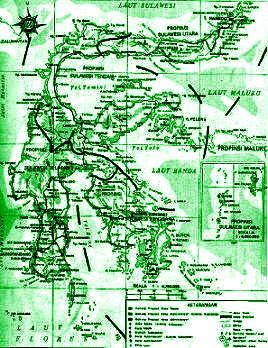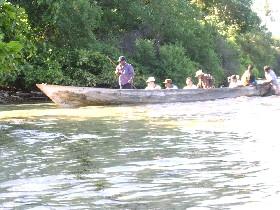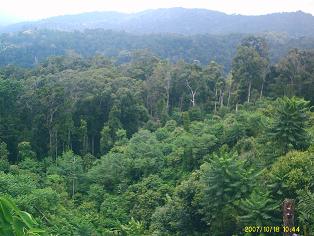| Sulawesi has a diverse system of protected areas, including six national parks (Lore Lindu -- a World Heritage Site and UNESCO Biosphere Reserve, established to protect landscape wildlife values and social customs in the adjoining communities; Nani Warta Bone; Bunaken-Manado Tua Marine National Park; Taka Bone Rate; Rawa Aopa- Watumohai and Wakatobi) (Ministry of Forestry/UNESCO/CIFOR 2003). Sulawesi also has 19 nature reserves and an assortment of tourism parks and wildlife refuges (World Bank 2001). These areas cover most major habitats and at face value represent most of the key elements of the island’s biodiversity.
The south peninsula of Sulawesi has 26 conservation areas, but none that are of a substantial size and capture the full dimension of a landscape. There are also no national parks in this biounit, despite the fact that, at least for some vertebrate groups, it is the most biologically divergent of the biounits. It is also a region where land conversion is most marked such that little land remains for selecting additional conservation reserves to represent the region.
|

|
The northern Peninsula biounit is the best protected, at least on paper. It has Bogani Nani Wartabone National Park (300,000 ha), which represents a range of habitats from 50 m to 2,000 m in altitude. It has a rich assemblage of vertebrates and most of the charismatic species for Sulawesi mentioned above. Tangkoko-Duasudara Nature Reserve (8,867 ha) on the northeast tip of the northern peninsula in the Kabupaten of Minahasa is one of the most important conservation sites in North Sulawesi. It contains the highest population densities of several of Sulawesi’s endemic species including the Crested Black Macaque, Spectral Tarsier, and Red-knobbed hornbill. The reserve contains three volcanoes: the 1,109 m Gn. Tangkoko (formerly known as Gn. Batuangas) and the parasitic ash cone of Batuangasis. This topography provides for many habitats, including Alang alang grassland, secondary scrub, Casuarina Forest, Beach Forest, Lowland Rainforest, Montane Rainforest, and Cloud Forest. The Reserve suffers many threats, including logging, fires, agricultural encroachment, harvesting of Livistonia palms and other nontimber forest products (Lee at al. 2000).
Central Sulawesi has Lore Lindu National Park (217,991 ha), which ranges in altitude from 500 to 2,600 m. It is a landscape scale Park that has Sub-alpine Forest through to Lowland Rainforests that support 117 mammal, 88 bird, 29 reptile and 19 amphibian species. It was declared by UNESCO in 1977 as a Biosphere Reserve. Although the central Luwuk peninsula and Banggai and Togian Islands appear to be lumped with the rest of the central region as a biounit, few biological surveys have been carried out there. Further, there remain extensive forested areas and opportunities to gain additional representation of the Luwuk Peninsula and Banggai islands and to coalesce existing proposed conservation areas (Whitten et al. 2002:104) into larger more landscape scale representative protected areas.
The Southeast biounit, including Buton Island, has 17 protected areas or proposed protected areas (Whitten et al. 2002), including Rawa Aopa Watmohai National Park (105,194 ha). This Park ranges from the coast to an altitude of 981 m and has lower Montane Rainforest, Lowland Rainforest, Mangrove Forest, Coastal Savanna and Freshwater Swamp Forests. It has a remarkable variety of plants including at least 257 genera and 323 species as well as a wide variety of vertebrate species, including 155 species of bird (MoF/UNESCO/CIFOR 2003).
None of these protected areas are safe from encroachment, conversion or illegal logging, which is often tacitly accepted by conservation authorities and local governments, who remain unconvinced of the economic and social value of these parks.
|
Mining, both legal and illegal, continues unabated in protected areas; it has been particularly damaging in Bogani Nani Wartabone National Park. Currently some 4,000 illegal gold miners work the slopes of the Park. An additional 5,000 gold miners work illegally a foreign owned lease near Manado, impacting the waters surrounding Bunaken Marine National Park (Sydney Morning Herald 2000). In Lore Lindu National Park, the Park authorities recently allowed local migrants to encroach park land and turned over 2000 ha to these migrants, rather than defend the Park (Indonesian Observer 2000).
Next >>> |
Source :
Report on Biodiversity and Tropical Forests in Indonesia.
Prepared by Steve Rhee, M.E.Sc.
Darrell Kitchener, Ph.D.
Tim Brown, Ph.D. Reed Merrill, M.Sc. Russ Dilts, Ph.D. Stacey Tighe, Ph.D.
|
|




